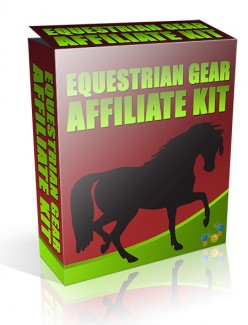
 License Type: Resell Rights
License Type: Resell Rights  File Size: 18,051 KB
File Size: 18,051 KB File Type: ZIP
File Type: ZIP
 SKU: 51468
SKU: 51468  Shipping: Online Download
Shipping: Online Download
Ebook Sample Content Preview:
Horse owners must have adequate fencing to safely contain and manage their horses. Fencing often is considered just a means of containing horses, which is especially important in urban areas. But fencing is much more than that. Daily labor needs and routines are influenced by the fencing plan.
The key to good horse fencing is proper construction and adequate maintenance. Safety of the handlers, visitors and the horses must receive first priority in designing horse fencing. Cost is a major consideration, but it should not dictate unsafe or inefficient fencing. While aesthetics should be considered, it should not overrule safe, functional fencing. For example, do not place boards on the outside of posts just because it looks nicer; it’s safer for horses and more functional to place the boards on the inside of the posts where leaning against the fence will not loosen boards.
Barbed wire should not be used for horses, and electric fencing alone is not recommended for perimeter fences. However, because horses are sensitive to electric shock, they can be easily trained to respect electric fences. A major concern is visibility. Electric fencing made of wide tape addresses this concern, but those tapes tend to be relatively poor conductors and do not last long. Another option is plastic-coated, 12.5-gauge, high-tensile wire developed specifically for the horse industry. It is more visible, attractive and safer than uncoated wire.
If wire is used, it should be smooth. A fence made of 12.5-gauge, high-tensile wire with a tape for visibility works well. If electric fencing is used for perimeter fencing, four to five strands should be used. The top wire should be 40-50 inches above the ground.
Choose fencing that safely meets your economic and aesthetic needs. To minimize damage and maintenance to your fences, consider using an electric strand on top of PVC or wooden fencing if your horse is a cribber or if it chews.
Keep in mind a few basic fencing needs of horses when you make your choice. The general rule is that the top of the fence should be at eye level to the horse. This discourages horses from jumping over the fence.
Lightweight, temporary electric fencing consisting of polytape, polyrope or polywire
strung on lightweight plastic or fiberglass posts works well for dividing a pasture into paddocks in a rotational-grazing system. Use of small, uncoated, 14-gauge or 18-gauge wire commonly used with cattle is not recommended because it is not safe for horses, primarily because they cannot see it. Because of their poor eyesight, horses often make contact with the electric fence, which shocks them and makes them run. This can be disastrous if the wire gets wrapped around a horse’s leg. The small wire can also cut horses when they run into it.
There is no forage that is best for all situations. Several forages, singly or in combinations, make good horse pastures. But not all forages are suited for horses. Forages are classified as grasses or legumes, and further defined as cool-season grasses or warm-season grasses. Some are perennials and some are annuals.
Horse pastures should have one or two grass species that grow well on a specific soil type, plus a legume that is well adapted to the soil, Adding one or two other grass or legume species to this mixture can extend the growing season because each species has a time of the year when it produces best. By using several species, owners could provide horses with adequate pasture for most of the year
Keep in mind that horses are picky eaters, and will overgraze the grasses they like best while ignoring the other forages. Some horses also prefer grasses over legumes However, legume forages are more nutritious than grass forages, and they enhance the nutrition of grasses because of their nitrogen-fixing capabilities. A well-managed rotational-grazing system encourages horses to utilize all of the forage species in a paddock.
Soil Erosion
Soil erosion can be a serious problem on pastures or paddocks. Any sloping area that is not adequately protected with healthy vegetation is likely to produce sediment-laden runoff that has offsite impacts, especially in streams and lakes. Erosion can occur as sheet or rill soil movement, which is subtle, or in concentrated flow as gullies, which can become deep enough to risk animal injury. Fencelines that run up and down hill can be very susceptible to gully erosion due to the typical concentration of the animals along the fence, eliminating all vegetation.
Any gullied areas in pastures or paddocks must be filled and graded to eliminate the hazard. Pastures should be reseeded immediately after grading. Horses must be kept off of repaired and reseeded areas to allow the vegetation to establish.
In a pasture, maintain adequate vegetation for animal nutrition and soil protection. This is done through rotational grazing and forage overseeding. At times even seeding of annual grasses can be prudent if quick cover is needed before the desirable forage species can re-establish.
Keep "clean water clean." Use grassed waterways, diversions, or subsurface drains to divert clean runoff around barns, manure storage areas, and paddocks.
Install and maintain a system of properly sized roof gutters, downspouts, and drains to prevent roof water from becoming polluted by mixing with barnyard manure and sediment.
Separate barnyards, paddocks, and manure storage areas from any waterway with filter strips of vegetation to trap sediments and absorb nutrients in runoff.
Soil Compaction
Compaction of the soil surface can greatly reduce rainfall storage and increase runoff and erosion. A porous soil improves plant vigor by allowing the infiltration of water, air, and nutrients. Hoof impact and machinery operation on wetter fields compact soils and intensify loss of this porosity.
Soils that are higher in clay content are more susceptible to hoof compaction than sandier soils.
One of the methods commonly used to reduce soil compaction is to aerate. Aerators are available for purchase or rent and easily hook up to a tractor with a 3-point hitch. Core aerating, which pulls 3-4 inch cores of soil, is generally more beneficial than tine aeration, which cuts narrow 2-3 inch slots. The best time to aerate is in the spring or early summer when grasses are growing most actively. Aerating can be done as part of a fertilizing and reseeding process. Aerate when soils are not wet.
- File Size:18,051 KB
- License: Resell Rights
- Category:Ebooks
- Tags:2014 Ebooks Resale Rights







